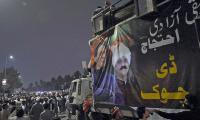The China-Pakistan Economic Corridor (CPEC) is not an ordinary run-of-the-mill project; it involves massive economic activity. Its impact is already being felt in Pakistan, albeit not in the way it was expected. Though the Afghan corridor, which can link the CPEC, remains unavailable due to instability, the government continues to sell the project as a game-changer for the region.
This commercial project was offered formally in May 2013 to Pakistan. The diktat of China’s own priorities and needs was the prime mover behind the offer. One must realise that corridor diplomacy connects China with 60 countries, setting up potential trade with a further 4.4 billion people and boosting China’s GDP by 25 percent.
The CPEC is one of the six corridors envisaged under the One Belt, One Road project (OBOR) at a cost of $900 billion. The proposed corridors are the China-Mongolia-Russia Economic Corridor (CMREC), New Eurasian Land Bridge (NELB), China-Central and West Asia Economic Corridor (CCWAEC), China-Indo-China Peninsula Economic Corridor (CICPEC), CPEC and Bangladesh-China-India-Myanmar Economic Corridor (BCIMEC). Except for the CPEC, all other corridors have so far remained non-controversial. But that does not mean that they are faring better than the CPEC.
Opposition from India and US was expected. India reiterated the objection it had raised in the 1960s when China and Pakistan finalised their borders and consequently built the Karakoram Highway on territory claimed by both India and Pakistan.
Another reason for the Indian opposition could be the Modi government’s known policy to deny any opportunity to Pakistan to consolidate its economy. The US is worried that the CPEC would facilitate stationing of the Chinese navy in the Indian Ocean. It supports India’s position that India alone has primacy right in the Indian Ocean. This fits well in with its global agenda to prop up India to counter the rising power of China. The US and its allies deny that they want to curtail China. Even with the US contention that it is managing uncertainties in the relations and not curtailing China, the Chinese presence in Indian Ocean is not one the US thinks will be a trust-building act.
China and Pakistan have always known the impending external threats. They both knew that regional instability would multiply the deadly effect of hostile activities carried out by India against Pakistan. What they were not aware of or prepared for was the scale of Pakistan’s international difficulties and domestic opposition to whatever would be agreed between the two states.
Pakistan and China will have to live with regional instability for some time, as they alone cannot handle the Afghanistan imbroglio and the terrorists active in the region. Despite tall claims, Pakistan is hardly in a position to provide foolproof protection to Chinese workers as demanded by China. The domestic opposition though is not about the utility of the CPEC for Pakistan but the composition and spread of its projects and non-transparency of the associated financial arrangements.
The size of the CPEC should have worked as a glue to bind different provinces. It has in fact pitted them against each other. The blame for that lies squarely with the federal government, and not with the smaller provinces. Four mistakes were made by Islamabad:
First, the CPEC has been over-sold, creating very high expectations such as $46 billion Chinese investment and the ratchet-up impact consisting of foreign investment worth more than $150 billion in the CPEC projects and many million dollars more being brought in to develop industrial skills, education, health and mining. Wild guesses about how investment from China will boost Pakistan’s GDP of $274 billion by over 15 percent continue to appear in the media. Incidentally, Pakistan has slipped from the 136th in 2015 to the 138th position among 189 countries in the World Bank’s Ease of Doing Business Ranking in 2016, constraining private investment and economic growth.
Second, the federal government has not done enough to resolve the controversy over the distribution of projects despite claims that the policy guidelines of all political parties held on May 28, 2015 and January 15, 2016 regarding the construction of the western route are being fully implemented. As it is, the CPEC lacks inclusive development, particularly that of Balochistan, Khyber Pakhtunkhwa, the Federally Administered Tribal Areas and Gilgit-Baltistan. The Chinese are unnecessarily being dragged into the controversy regarding the present distribution of projects, as they will do what the federal government has mutually agreed with them.
Third, the federal government has not come up with the full details of financial arrangements involving the CPEC projects despite receiving directives from the Lahore High Court. No one, including the State Bank of Pakistan, seems to know that the exact number of grants or loans being arranged from China for the CPEC and what the debt liability will be at the end of the day. The IMF has recently warned that “as Chinese IPPs start their operations, profit repatriation by these firms would begin to rise in subsequent years...[and] these outflows could reach about 0.4 percent of GDP per year over the longer run”.
Who will pay the debt? Will the onus fall on all provinces or will each province pay for projects and infrastructure built on its territory? No decision in this regard has been taken or, if taken, has not been shared with provinces as yet. Against this background, smaller provinces are worried that they would be expected to pay for projects in Punjab while meeting debt obligations.
Fourth, the government has been slow in convincing the business community in Pakistan that the CPEC is not all about the trading and dumping of Chinese products in Pakistan. The government has come up with proposals to set up manufacturing economic zones, universities and heath facilities. It will be reassuring if the government sets aside funds for the proposed facilities and starts construction work.
The CPEC is the pilot project of the OBOR. China would like the project to move forward as it will bring economic gains and expand its political influence through physical presence of its navy at Gwadar Seaport. China’s sustained interest in the project is a plus point for Pakistan but the CPEC should not be treated as an act of benevolence. The cost of security cover, therefore, should be built in the commercially negotiated deals and not passed on to energy consumers to avoid public reaction as witnessed recently in TV debates and references to higher courts.
The CPEC is a big venture and involves provincial governments. Its pace of implementation may be slower in some projects than in others. Nevertheless, it will come through.
The government should not delay reforms in the financial sector. This will support growth and generate adequate resources to pay for the gap in the available funding and meet debt payment obligations.
The flipside is that the government is in a difficult situation to raise $28 billion allocated to ‘early harvest’ infrastructure projects. The government will execute projects to the tune of $10 billion through the regular development-spending envelope and the remaining $18 billion will be funded via foreign direct investment.
The writer is a former ambassador,
political analyst and advisor to CRSS, an independent think tank.
Email: mian.sana@gmail.com
Data, today, defines how we make decisions with tools allowing us to analyse experience more precisely
But if history has shown us anything, it is that rivals can eventually unite when stakes are high enough
Imagine a classroom where students are encouraged to question, and think deeply
Pakistan’s wheat farmers face unusually large pitfalls highlighting root cause of downward slide in agriculture
In agriculture, Pakistan moved up from 48th rank in year 2000 to an impressive ranking of 15th by year 2023
Born in Allahabad in 1943, Saeeda Gazdar migrated to Pakistan after Partition







